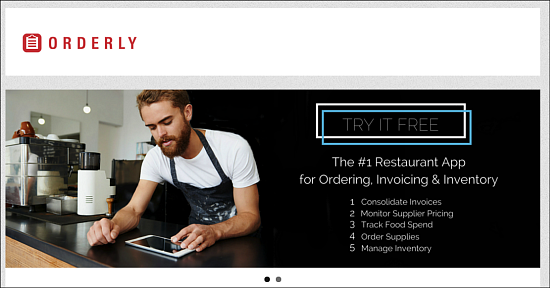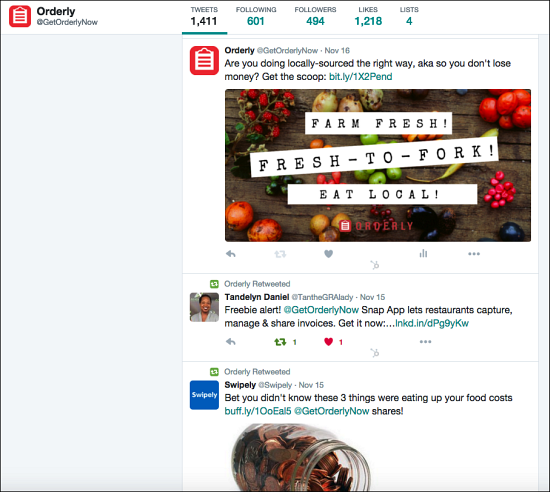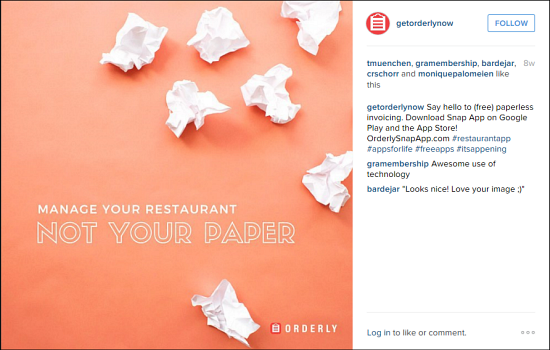by
Shelby Dorsey, Copy Editor
THE CUSTOMER
Orderly is a restaurant app that allows restaurants to virtually order, invoice and manage inventory.
"For the past … forever, really, restaurants have been using these manual processes," Joy Ugi, Digital Marketing Manager, Orderly, said. Orderly allows restaurants to do away with paper invoices and to manage these processes through the app.
Orderly serves its customers in two ways. For three years, Orderly has had "
invoice management, ordering and inventory tools" available through its SaaS technology, Ugi said. The other service Orderly provides to customers is the free Orderly Snap App, which is paperless invoicing for restaurants. The Orderly Snap App is just a few months old.

Click here to see the full version of this creative sample
In the beginning, Orderly was created to benefit small, independently owned restaurants. However, Ugi said that Orderly is now seeing interest from "multi-unit restaurants," meaning restaurants with between two and 15 locations.
CHALLENGE
When the company rebranded in summer of 2015 Orderly's SaaS platform had already been running for roughly two years under the company name "Siftit." With the rebranding, Ugi was brought on to start Orderly's marketing effort.
At this point, the extent of Orderly's marketing strategy was the existence of its website and a small social media presence.
One of the biggest challenges Orderly faced was a lack of customer knowledge about the company. With the rebranding, Orderly was virtually a new company with minimal marketing being done.
Secondly, Orderly uses paperless technology that is very new to the restaurant world. The current invoicing system used by most restaurants is a very manual process, and "it's how it's always been done," Ugi said. This meant the team had to also prove the value of this system itself, and getting customers to evolve and adapt was a challenge.
THE CAMPAIGN
The marketing team at Orderly is small — it is made up of Ugi and the company's vice president of Marketing and Sales, Tim Muenchen, who splits his time between the two departments. They made their marketing goal "to do the most impactful things first" and then progress from there, Ugi said.
Ugi wanted to increase the authority of Orderly's website through inbound tactics.
It was also important in this effort for the marketing team to launch a content marketing strategy. They created a blog and established a heavier social media presence.
Step #1. Refine SEO and landing page copy
When looking to make the site more authoritative and prominent, Ugi decided to refine SEO with very basic practices.
Marketing began creating landing pages around a pre-determined keyword. For instance, the team decided that they wanted "restaurant purchasing app" to be the main keyword for the site. Ugi then added this phrase to the copy on the homepage. This same process was used on other webpages.
Two of the key landing pages that were specialized for SEO were the demo and the free trial webpages. When Ugi first started with Orderly, the company would show up on the bottom of the first page of an Internet search, she said. The basic SEO strategies used by the team have now put the company at the top of the first page.
"Every week, we would really just look at this landing page, and look at it with fresh eyes [to] see what could be made better," Ugi said.
The marketing team would speak weekly with customers and prospects, then use these different perspectives to rework the copy on the landing pages.
"We're both big learners … We read a bunch of different marketing blogs. So we would come back with something new about copywriting that we thought we could use to improve the landing page," Ugi said.
Eventually, though, the team knew it had to stop refining the copy and test what they had created, so the pages were worked on in May and then pushed live in June. After being published, the pages were left alone "for a couple of months" without any copy changes being made, according to Ugi.
After the trial period — which was about two months long — the landing pages showed a consistent conversion rate of about 4%.
In September, Ugi said her vice president of Marketing challenged the team to double this conversion rate in a continuing effort to improve, "so we went back to the drawing board."
In re-examining these pages, Ugi said the team realized that with the launch of the free trial page, they had been talking primarily to chefs.
Now, three months into this marketing campaign, Ugi's team realized that managers were actually the decision makers. This caused Orderly to change images on the
landing pages in an effort to engage managers rather than chefs.

Click here to see the full version of this creative sample
With this change in understanding about who Orderly's audience is, the team doubled their conversion rate in September.
Step #2. Launch content marketing strategy
Orderly launched a blog and email nurture program with two objectives in mind:
- To stay in touch with prospects
- To drive traffic to the website
The team first created a content calendar, picking topics they felt would be most relevant to customers. Ugi points to the fact that, because many Orderly employees were former chefs, they are a great resource when deciding what content to feature.
For example, when the avian flu appeared in September, the team saw this as an opportunity to write informative content about how restaurants could deal with this issue. With an increase in food prices, many restaurants were closing for breakfast and making other comparable decisions to save costs.
"They could change their menu so it didn't include as many eggs. Or we provided a list of egg substitutes that would work," Ugi said.
All of the content is published with a call-to-action. The goal of Orderly’s blog and social media content is to stay relevant and helpful to its audience by writing about issues that the customers care about. After reading an informative article, the call-to-action allows readers to know what to do next.
When the team first started, they weren't doing any targeting with content. Currently, Ugi said the team targets "our restaurant managers or operators because we know they're the ones who will use the information the most or the information will be most useful to them."
Orderly also has a weekly email newsletter that features the newest blog post. This is another way to softly communicate with customers without pushing a product.
Step #3. Develop a social media presence
In its move to have more of a social presence, Orderly uses a variety of social media platforms but uses them all differently.
"I think as far as volume, I am posting most on
Twitter because that's what kind of platform it is. If somebody doesn't see your post in the first five seconds it's posted, they're probably not going to see it," Ugi said.

Click here to see the full version of this creative sample
When producing a lot of short content quickly, Ugi said Twitter and even LinkedIn work best for Orderly because they are very fast moving social media platforms. For Facebook, Orderly posts less but makes sure the content that is published is a "super quality posting."
Instagram requires a slightly different approach because it is a primarily visual platform. Ugi said she doesn't post to the Orderly account unless there is a particularly striking image, so Instagram is updated less often than other accounts.

Click here to see the full version of this creative sample
"I think Instagram has to be handled with kid gloves by B2B marketers. You can't just push out any old thing, so my Instagram strategy is a little bit slower," Ugi said.
RESULTS
Orderly has been able to increase traffic, views and leads through these inbound marketing efforts:
- A 100% increase in inbound leads
- 9,000 blog views in five months
- Blog traffic representing 23% of total website traffic
Ugi said consistency is key when looking to improving marketing efforts.
"If you're testing, be consistent about it. … Every week, I look at my paid search ads to see what's doing well, what's not doing well, what I can switch out," she said.
Her advice to other marketers would be to spend time planning "four or five" marketing efforts that will be impactful over a period of six months or so and focus on doing those few things very well.
Creative Samples
- Orderly purchasing technology ad
- Orderly landing page
- Orderly Twitter feed
- Orderly Instagram post
Sources
OrderlyRelated Resources
MarketingSherpa Summit 2016 — At the Bellagio in Las Vegas, February 22-24
Inbound Marketing: Entertainment venue Topgolf increases Twitter followers 182% with relevant outreachInbound Marketing: How to turn your customers into brand enthusiasts [From the MarketingSherpa blog]













